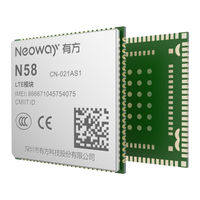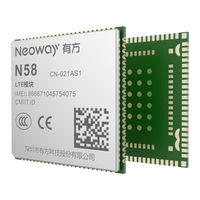
Neoway N58 LTE Module Manuals
Manuals and User Guides for Neoway N58 LTE Module. We have 4 Neoway N58 LTE Module manuals available for free PDF download: Hardware User's Manual
Neoway N58 Hardware User's Manual (88 pages)
Brand: Neoway
|
Category: Wireless modules
|
Size: 2 MB
Table of Contents
Advertisement
Neoway N58 Hardware User's Manual (87 pages)
Brand: Neoway
|
Category: Network Router
|
Size: 3 MB
Table of Contents
Neoway N58 Hardware User's Manual (74 pages)
Industrial 4G module
Brand: Neoway
|
Category: Control Unit
|
Size: 2 MB
Table of Contents
Advertisement
Neoway N58 Hardware User's Manual (45 pages)
Mini PCIe
Brand: Neoway
|
Category: GSM/GPRS Modules
|
Size: 1 MB



